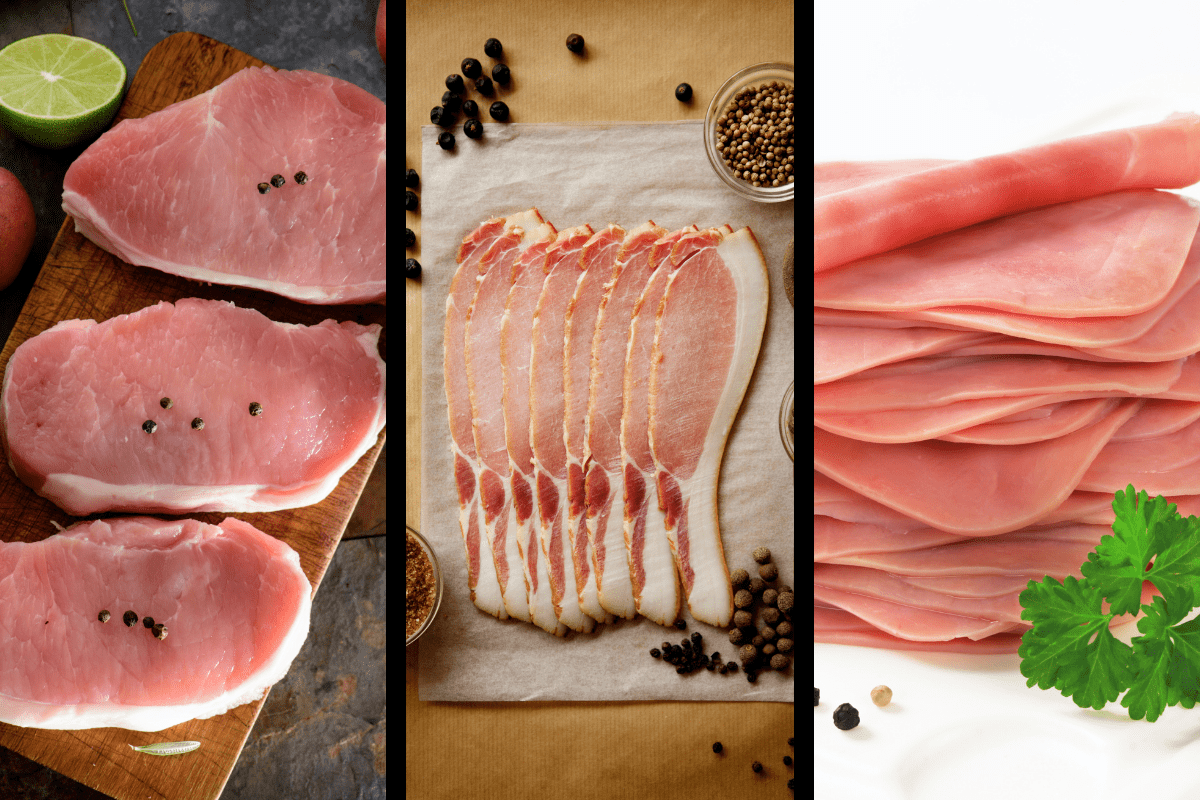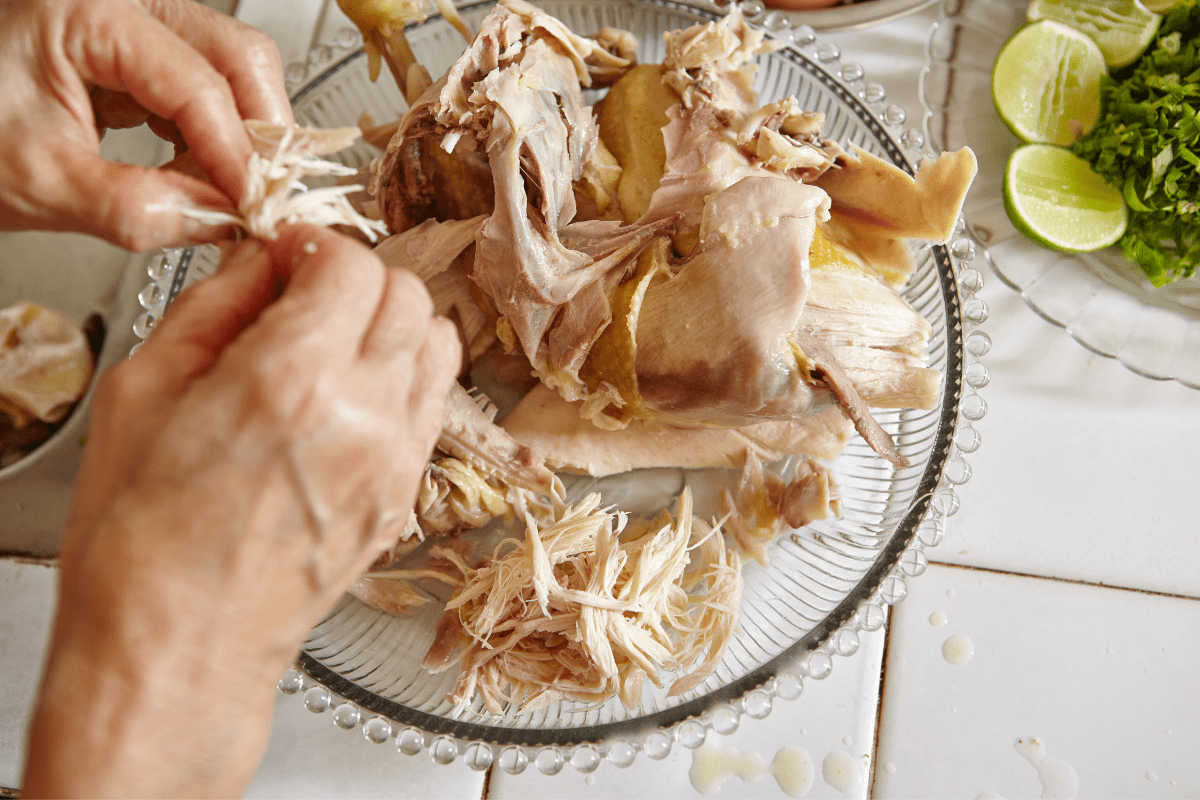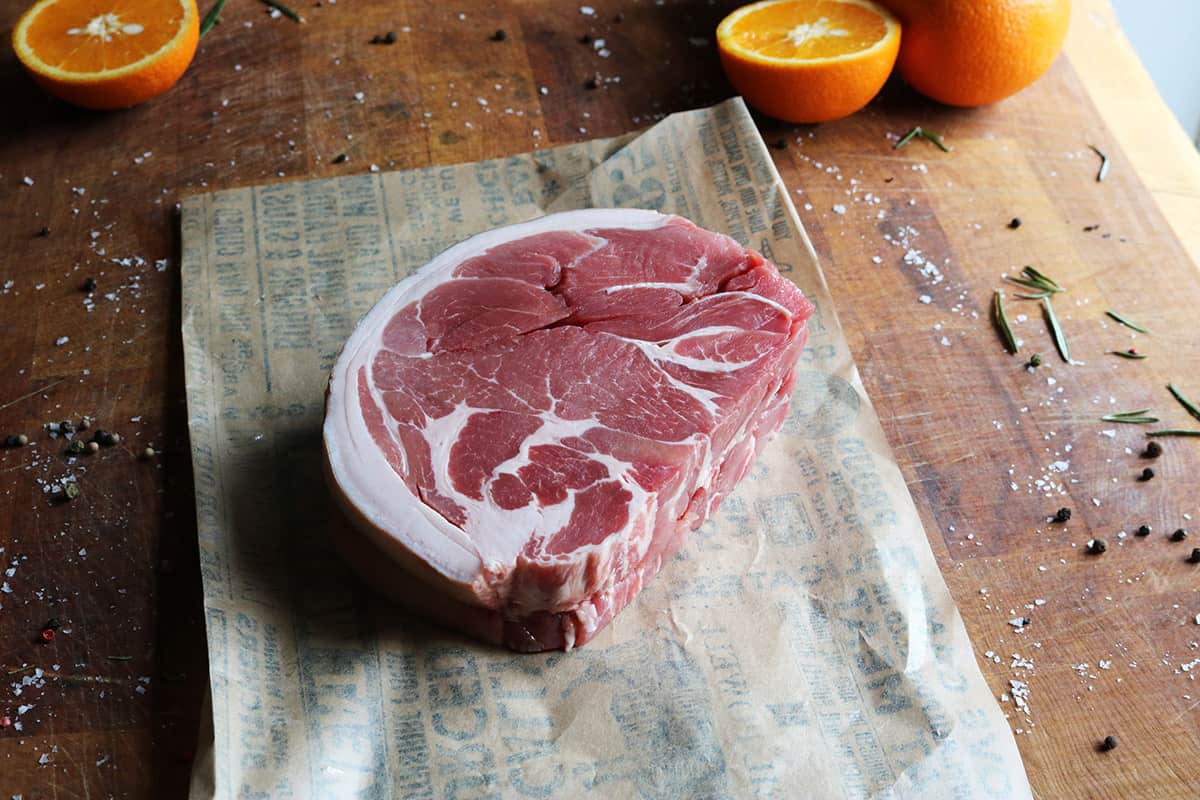When it comes to buying different types of meat, there is sometimes confusion over which product to buy if you are not familiar with the product name. Different types of cured pork are a prime example so let’s clear things up a little bit for you.
So what is the difference between pork, ham, bacon and gammon? Pork is the uncured meat from a pig. Ham, bacon and gammon are pork cuts that have been cured in some way, such as salting, brining or smoking. The shoulder, belly and loin of pork are used to make bacon, and the leg of pork is used for hams.
Now we will look at each type of meat in more detail to explain how they differ.
Fresh Pork
When a pig is slaughtered for meat, the flesh of the meat is known as pork.
The main primal cuts that are produced from a pig are the Leg, Loin, Belly and Shoulder.
Here is a brief guide to what each of these primal cuts provides in cuts of meat that may be familiar to you.
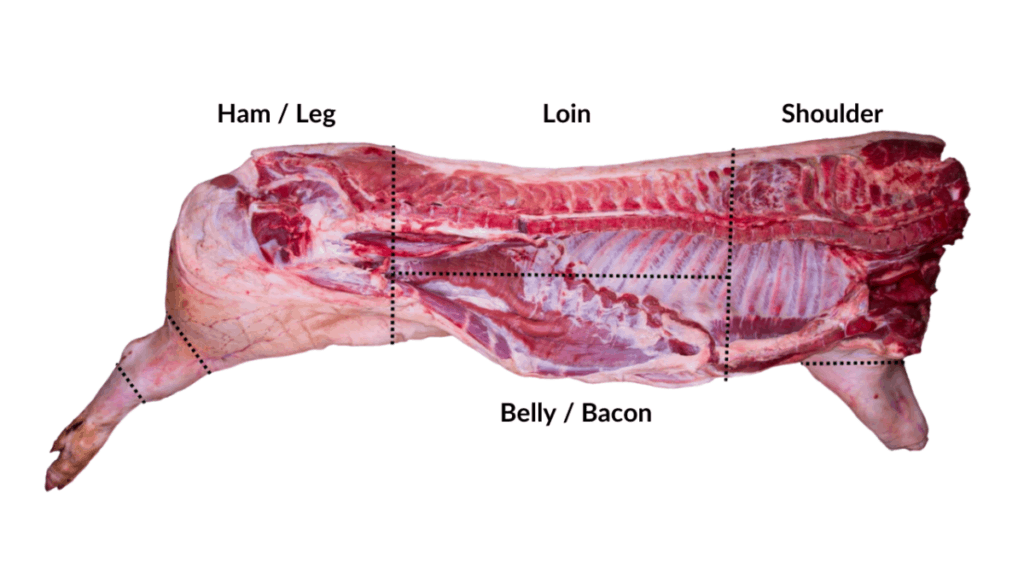
Leg of pork
The leg of pork is commonly used for roasting joints, pork steaks and diced pork for kebobs etc. In the USA the fresh uncooked leg of pork can also be known as the ‘ham’ which is not to be confused with the ‘cooked ham’ that you get in the UK.
Shoulder of Pork
The shoulder of pork can be sold in a variety of ways. It is commonly divided into 2 sections known as the picnic and the butt.
Sometimes the shoulder is sold as slow roasting joints that provide dishes such as ‘pulled pork’, but can also be cut into shoulder chops.
The pork butt is often used in for making of sausages due to it’s fat content, and is also sold as ground pork.
In the UK, the shoulder can often be cured in brine and then becomes a ‘collar of bacon’ (more on that below!)
Belly of Pork
In the USA, the pork belly is the most common cut used for making bacon, having also been smoked.
In the UK, the belly is a cut favored to be cooked as fresh pork. It is sold as bone-in, or boneless roasts or slices. The fresh belly pork will usually have the skin attached to provide ‘crackling’, and is quite often rolled with a bread stuffing filling.
If the pork belly is cured as bacon in the UK, it can be both smoked or unsmoked, and is referred to as ‘Streaky’ bacon due to the streaks of fat running through the meat.
Loin of Pork
The loin of pork is the ‘back’ of the pig that runs between the leg and shoulder. This is where the ‘chops’ are taken from, as well as the pork loin roasts, and centre cut pork loin steaks.
The pork loin is probably the most common cut to be turned into bacon in the UK. It is cured and can be sold smoked or unsmoked (aka: ‘green’). Bacon cured from the loin is also known as ‘back’ bacon in the UK.
You can see a full account of the different pork cuts in our article: Pork Cuts Explained – A Shoppers Guide
Cured Pork
When fresh pork is cured in some way, it then becomes Bacon, Gammon or Ham, depending on which cut of pork you are curing.
Before we get onto the differences between the cuts of pork used, we will firstly explain the different types of curing that may take place with the meat.
Any of these curing methods can be used in the production of Ham, Gammon and Bacon, depending on the desired end result wanted.
Dry Curing
Dry curing bacon involves the meat being packed in a dry salt rub rather than immersed or injected with a wet brine.
The dry salt can be combined with other flavors and ingredients to provide a desired taste to the bacon. For instance herbs or spices may be used as part of the salt rub to provide a distinctive taste.
The dry cured bacon may also be smoked after the curing process.
Dry cured bacon takes longer to process than wet cured products, due to length of time needed for the salt to fully penetrate through to the centre of the meat. As you would imagine, the end result tends to be a more salty tasting bacon.
Wet Cured / Brine Cured
Wet curing or brine curing involves the fresh pork being immersed or injected with a wet salt solution. As with the dry curing, different flavors can be added to the wet brine solution to create a desired taste.
More traditional methods involved setting up a brine bath where the pork is fully immersed into the liquid brine. It is then left to cure for the desired amount of time before being used or smoked.
More commercial methods where speed is required, the pork is often injected with the brine so that it penetrates the meat much faster. It then may be vacuum packed with the brine to further speed up the curing process.
A liquid smoke solution may also be added to this process to provide a smoked ‘flavor’ to the meat, to further save the time and cost of smoking the meat in the traditional way.

Smoke Curing
Smoke curing may give the impression that it does the ‘curing’ process and so the wet or dry curing is not needed. This is NOT the case.
The smoking aspect of the curing process is mainly done to add flavor. The meat must be cured first, and then can be ‘hot’ or ‘cold’ smoked, depending on the type of finished product you are aiming for.
Hot Smoking
Hot smoking is where the cured meat is exposed to both heat and smoke to fully cook the product as well as adding the smoked flavor.
If you plan to ‘hot’ smoke your meat, it is not so essential to ensure that the meat is ‘fully’ cured prior to smoking. This is because any harmful bacteria will be eradicated during the cooking process.
Cold Smoking
Cold smoking involves adding the flavor of smoke without actually cooking the meat. It is a process that can take many days to complete depending on the desired end result required.
Cold smoked products will require cooking unless they have been preserved in another way such as drying, as is the case with salami meats.

Ok, so now that we have seen how fresh pork can be cured to become either ham, bacon or gammon, we will now look at what diferenciates these three products from each other.
Bacon
Bacon is the curing of three distinct primal cuts of the pig:
- Shoulder
- Loin (back)
- Belly
So lets look at each of these cuts of pork, and what names they are given after curing
Shoulder
In different parts of the world, the cured pork shoulder is known by different names and sold in different ways. For instance, in the UK it is sold raw and unsmoked and in Europe it is sold dried and cured like salami.
Here are some of the most common uses for cured shoulder of pork.
Collar of Bacon
In the UK, the boneless shoulder of pork is usually cured in a brine solution and becomes ‘Collar Bacon’
Collar bacon is more commonly sold raw and unsmoked, and cut into smaller portions known as ‘Joints’.
These joints are then boiled in water and either served sliced warm in dishes such and boiled bacon and cabbage, or left to go cold and sliced as cold cuts.
The collar bacon is not as readily available these days as it carries much more fat than the ‘ham/leg’, and so is not as desirable for todays health conscious eaters.
In the county of Lincolnshire in the UK, the whole collar of bacon is used to make their traditional dish known as ‘Stuffed Chine’. This involves cutting slits lenghtways along the collar and stuffing with minced fresh parsley before boiling. The collar is then left to cool and sliced as cold cuts.
Coppa / Capicola / Gabagool
This Italian delicacy is where the cured pork boneless shoulder is smoked and dry cured with a variety of seasonings for a very long time, usually 6 months or more.
The meat is then sliced very thinly like salami and served cold with cheeses and bread.
Back Bacon (loin)
The boneless loin of pork is more often used to create bacon in the UK. This is known a ‘back‘ bacon and consists of the eye of the loin, with a small portion of the belly attached. This can be sold smoked or unsmoked and is usually cut into thin slices (known as ‘rashers’ in the uk) for frying or grilling/broiling.

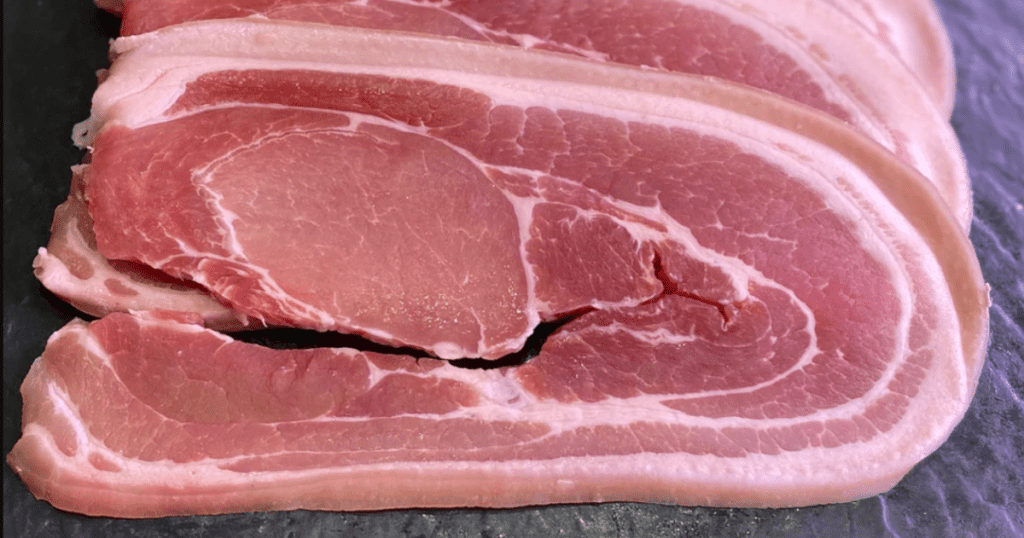
‘Middle or Middle back’ bacon is when the belly is left attached to the eye of the loin and creates a long tail to the bacon. This is effectively the back and streaky bacon left as one piece. You will often see this bacon with the rind still attached.
Streaky Bacon (belly)
When the fresh boneless pork belly is cured for bacon, it is often referred to as ‘Streaky’ bacon. This is due to the streaks of fat that run through the lean parts of the meat.
In the UK, the streaky bacon can be sold smoked or unsmoked, and cut into thin slices

Gammon / Ham (leg)
When the leg of pork is cured it creates a product called Gammon. This can be smoked or unsmoked and sold as steaks or in roasts / joints.
Gammon steaks are a popular food in the UK and will often be served in pubs and restaurants topped with a fried egg or pineapple slice, sometimes both!
A joint of gammon can be boiled, roasted, or boiled and roasted with a glaze poured over and basted during the roasting part of the cooking.

When a joint of Gammon is cooked, it then becomes known as ‘cooked ham‘.
So just to avoid the confusion:
Fresh Pork Leg is called – Leg of Pork
Cured Pork Leg is called – Gammon
Cooked Gammon is called – Roast or Boiled Ham
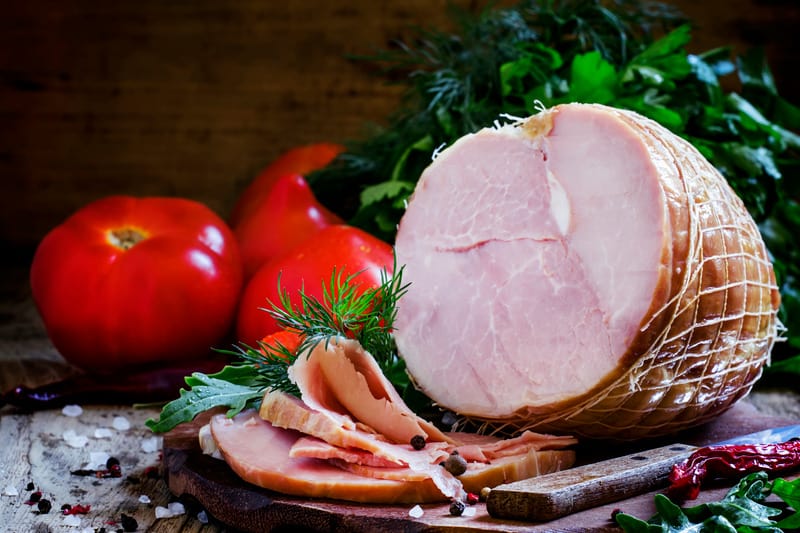
Hopefully this article has helped you understand the differences between Pork, Bacon, Gammon and Ham.
It can be a little confusing depending on where in the world you are asking, however, if you tell your butcher exactly what you want, they will be able to make sure you get the right product for your recipe!
